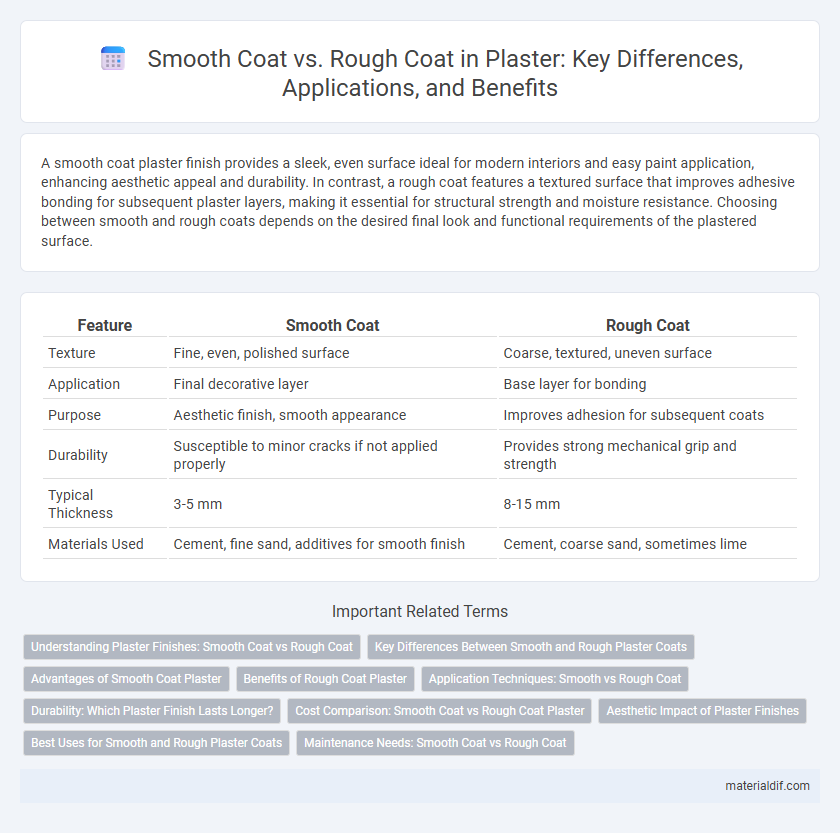A smooth coat plaster finish provides a sleek, even surface ideal for modern interiors and easy paint application, enhancing aesthetic appeal and durability. In contrast, a rough coat features a textured surface that improves adhesive bonding for subsequent plaster layers, making it essential for structural strength and moisture resistance. Choosing between smooth and rough coats depends on the desired final look and functional requirements of the plastered surface.
Table of Comparison
| Feature | Smooth Coat | Rough Coat |
|---|---|---|
| Texture | Fine, even, polished surface | Coarse, textured, uneven surface |
| Application | Final decorative layer | Base layer for bonding |
| Purpose | Aesthetic finish, smooth appearance | Improves adhesion for subsequent coats |
| Durability | Susceptible to minor cracks if not applied properly | Provides strong mechanical grip and strength |
| Typical Thickness | 3-5 mm | 8-15 mm |
| Materials Used | Cement, fine sand, additives for smooth finish | Cement, coarse sand, sometimes lime |
Understanding Plaster Finishes: Smooth Coat vs Rough Coat
Smooth coat plaster provides a sleek, even surface ideal for modern interiors, enhancing light reflection and ease of cleaning. Rough coat plaster, characterized by its textured finish, adds depth and rustic charm, often used for exterior walls to improve durability and grip for subsequent paint layers. Selecting between smooth and rough coat finishes depends on aesthetic preference, surface application, and functional requirements such as moisture resistance and maintenance.
Key Differences Between Smooth and Rough Plaster Coats
Smooth plaster coats create a sleek, even surface ideal for modern interiors, enhancing light reflection and providing a clean finish. Rough plaster coats feature a textured, uneven surface that adds character and better adhesion for subsequent layers or paint. Key differences lie in surface texture, application methods, and final aesthetic impact, with smooth coats prioritizing visual uniformity and rough coats emphasizing durability and grip.
Advantages of Smooth Coat Plaster
Smooth coat plaster provides a sleek, uniform finish that enhances the aesthetic appeal and allows for easier cleaning and maintenance, making it ideal for both residential and commercial interiors. Its dense and even surface improves resistance to moisture infiltration and minimizes dirt accumulation, contributing to longer-lasting wall protection. The smooth texture also facilitates better application of paints and wall coverings, resulting in a more durable and visually appealing finish.
Benefits of Rough Coat Plaster
Rough coat plaster provides superior adhesion, creating a strong base layer that enhances the durability of subsequent finishes. Its textured surface improves bonding with topcoats, reducing the risk of cracking and peeling over time. This type of plaster is especially beneficial in exterior applications where resistance to weathering and impact is crucial.
Application Techniques: Smooth vs Rough Coat
Smooth coat plaster requires precise troweling techniques to achieve an even, flat surface ideal for final decorative finishes, while rough coat plaster employs a coarse application to create a strong, textured base layer that improves adhesion for subsequent coats. Application of smooth coat involves fine, consistent strokes and frequent wetting to avoid cracks, whereas rough coat is applied with a firm scratch or stipple pattern to enhance bonding. Mastery of these techniques ensures structural integrity and optimal surface quality in plaster work.
Durability: Which Plaster Finish Lasts Longer?
Smooth coat plaster finish typically offers higher durability due to its compact and dense surface, which resists moisture penetration and reduces the risk of cracks. Rough coat plaster, with its textured and uneven finish, may be more prone to wear and weathering, leading to a shorter lifespan when exposed to harsh environmental conditions. Choosing a smooth coat enhances the longevity of plaster surfaces, particularly in exterior applications where durability is critical.
Cost Comparison: Smooth Coat vs Rough Coat Plaster
Smooth coat plaster typically incurs higher costs due to the finer materials and additional labor required for a flawless finish, averaging about 20-30% more than rough coat plaster. Rough coat plaster utilizes coarser aggregates and less intricate application techniques, making it a more budget-friendly option suited for base layers or textured surfaces. Cost efficiency in rough coat plaster is ideal for structural purposes, whereas smooth coat plaster is preferred for aesthetic applications despite the increased expense.
Aesthetic Impact of Plaster Finishes
A smooth plaster coat creates a sleek, polished surface that enhances light reflection and imparts a modern, clean aesthetic to interiors and exteriors. In contrast, a rough plaster coat offers a textured finish that adds depth and character, often used to evoke rustic or traditional styles. The choice between smooth and rough plaster significantly influences the visual appeal and architectural expression of a building facade.
Best Uses for Smooth and Rough Plaster Coats
Smooth plaster coats are ideal for interior walls and ceilings where a sleek, polished finish enhances aesthetics and facilitates easy painting or wallpaper application. Rough plaster coats provide superior adhesion on exterior surfaces or uneven substrates, preventing moisture infiltration and improving durability in harsh weather conditions. Selecting smooth coats suits modern, refined spaces, while rough coats excel in structural reinforcement and exterior protection.
Maintenance Needs: Smooth Coat vs Rough Coat
Smooth coat plaster requires regular cleaning to maintain its sleek appearance, as dirt and stains are more visible on its even surface. Rough coat plaster tends to hide minor imperfections and dirt, reducing the frequency of cleaning but may need periodic inspection to prevent buildup in crevices. Maintenance costs for smooth coats are generally higher due to the need for careful upkeep and potential touch-ups to avoid surface damage.
Smooth coat vs Rough coat Infographic

 materialdif.com
materialdif.com